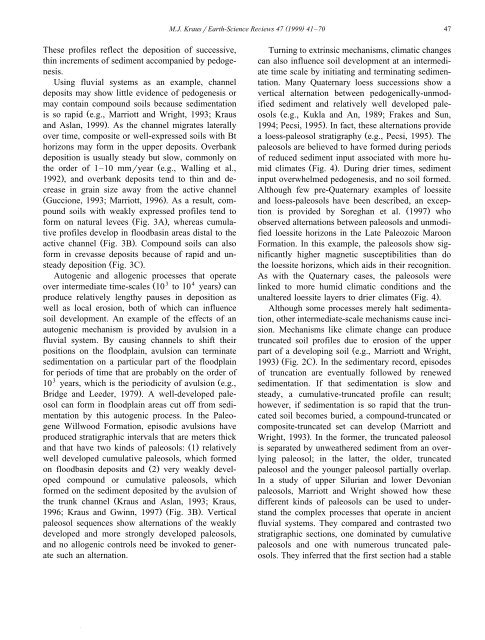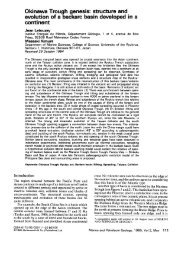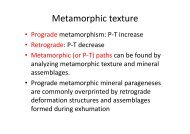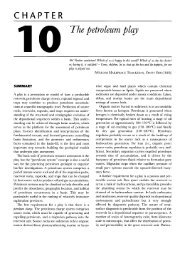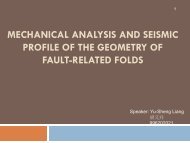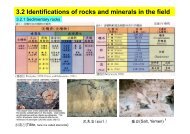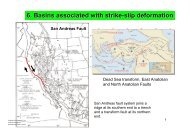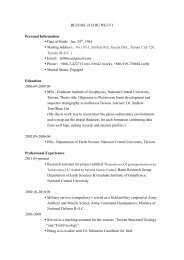Paleosols in clastic sedimentary rocks: their geologic applications
Paleosols in clastic sedimentary rocks: their geologic applications
Paleosols in clastic sedimentary rocks: their geologic applications
- No tags were found...
You also want an ePaper? Increase the reach of your titles
YUMPU automatically turns print PDFs into web optimized ePapers that Google loves.
( )M.J. KrausrEarth-Science ReÕiews 47 1999 41–70 47These profiles reflect the deposition of successive,th<strong>in</strong> <strong>in</strong>crements of sediment accompanied by pedogenesis.Us<strong>in</strong>g fluvial systems as an example, channeldeposits may show little evidence of pedogenesis ormay conta<strong>in</strong> compound soils because sedimentationis so rapid Že.g., Marriott and Wright, 1993; Krausand Aslan, 1999 .. As the channel migrates laterallyover time, composite or well-expressed soils with Bthorizons may form <strong>in</strong> the upper deposits. Overbankdeposition is usually steady but slow, commonly onthe order of 1–10 mmryear Že.g., Wall<strong>in</strong>g et al.,1992 ., and overbank deposits tend to th<strong>in</strong> and decrease<strong>in</strong> gra<strong>in</strong> size away from the active channelŽ Guccione, 1993; Marriott, 1996 .. As a result, compoundsoils with weakly expressed profiles tend toform on natural levees Ž Fig. 3A ., whereas cumulativeprofiles develop <strong>in</strong> floodbas<strong>in</strong> areas distal to theactive channel Ž Fig. 3B .. Compound soils can alsoform <strong>in</strong> crevasse deposits because of rapid and unsteadydeposition Ž Fig. 3C ..Autogenic and allogenic processes that operateŽ3 4over <strong>in</strong>termediate time-scales 10 to 10 years.canproduce relatively lengthy pauses <strong>in</strong> deposition aswell as local erosion, both of which can <strong>in</strong>fluencesoil development. An example of the effects of anautogenic mechanism is provided by avulsion <strong>in</strong> afluvial system. By caus<strong>in</strong>g channels to shift <strong>their</strong>positions on the floodpla<strong>in</strong>, avulsion can term<strong>in</strong>atesedimentation on a particular part of the floodpla<strong>in</strong>for periods of time that are probably on the order of310 years, which is the periodicity of avulsion Že.g.,Bridge and Leeder, 1979 .. A well-developed paleosolcan form <strong>in</strong> floodpla<strong>in</strong> areas cut off from sedimentationby this autogenic process. In the PaleogeneWillwood Formation, episodic avulsions haveproduced stratigraphic <strong>in</strong>tervals that are meters thickand that have two k<strong>in</strong>ds of paleosols: Ž. 1 relativelywell developed cumulative paleosols, which formedon floodbas<strong>in</strong> deposits and Ž. 2 very weakly developedcompound or cumulative paleosols, whichformed on the sediment deposited by the avulsion ofthe trunk channel ŽKraus and Aslan, 1993; Kraus,1996; Kraus and Gw<strong>in</strong>n, 1997.Ž Fig. 3B .. Verticalpaleosol sequences show alternations of the weaklydeveloped and more strongly developed paleosols,and no allogenic controls need be <strong>in</strong>voked to generatesuch an alternation.Turn<strong>in</strong>g to extr<strong>in</strong>sic mechanisms, climatic changescan also <strong>in</strong>fluence soil development at an <strong>in</strong>termediatetime scale by <strong>in</strong>itiat<strong>in</strong>g and term<strong>in</strong>at<strong>in</strong>g sedimentation.Many Quaternary loess successions show avertical alternation between pedogenically-unmodifiedsediment and relatively well developed paleosolsŽe.g., Kukla and An, 1989; Frakes and Sun,1994; Pecsi, 1995 .. In fact, these alternations providea loess-paleosol stratigraphy Ž e.g., Pecsi, 1995 .. Thepaleosols are believed to have formed dur<strong>in</strong>g periodsof reduced sediment <strong>in</strong>put associated with more humidclimates Ž Fig. 4 .. Dur<strong>in</strong>g drier times, sediment<strong>in</strong>put overwhelmed pedogenesis, and no soil formed.Although few pre-Quaternary examples of loessiteand loess-paleosols have been described, an exceptionis provided by Soreghan et al. Ž 1997.whoobserved alternations between paleosols and unmodifiedloessite horizons <strong>in</strong> the Late Paleozoic MaroonFormation. In this example, the paleosols show significantlyhigher magnetic susceptibilities than dothe loessite horizons, which aids <strong>in</strong> <strong>their</strong> recognition.As with the Quaternary cases, the paleosols werel<strong>in</strong>ked to more humid climatic conditions and theunaltered loessite layers to drier climates Ž Fig. 4 ..Although some processes merely halt sedimentation,other <strong>in</strong>termediate-scale mechanisms cause <strong>in</strong>cision.Mechanisms like climate change can producetruncated soil profiles due to erosion of the upperpart of a develop<strong>in</strong>g soil Že.g., Marriott and Wright,1993.Ž Fig. 2C .. In the <strong>sedimentary</strong> record, episodesof truncation are eventually followed by renewedsedimentation. If that sedimentation is slow andsteady, a cumulative-truncated profile can result;however, if sedimentation is so rapid that the truncatedsoil becomes buried, a compound-truncated orcomposite-truncated set can develop ŽMarriott andWright, 1993 .. In the former, the truncated paleosolis separated by unweathered sediment from an overly<strong>in</strong>gpaleosol; <strong>in</strong> the latter, the older, truncatedpaleosol and the younger paleosol partially overlap.In a study of upper Silurian and lower Devonianpaleosols, Marriott and Wright showed how thesedifferent k<strong>in</strong>ds of paleosols can be used to understandthe complex processes that operate <strong>in</strong> ancientfluvial systems. They compared and contrasted twostratigraphic sections, one dom<strong>in</strong>ated by cumulativepaleosols and one with numerous truncated paleosols.They <strong>in</strong>ferred that the first section had a stable


